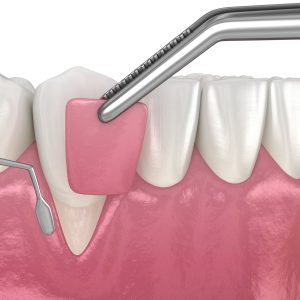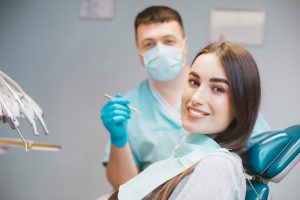Rebuild Your Gum Line: The Transformative Power of Gum Grafting
At the West Sayville, NY dental practice of Dr. Richard Sigismondi, we’re committed to providing comprehensive solutions that address the unique needs of each patient. For individuals suffering from gum recession, a common yet often overlooked condition, we offer gum grafting – a restorative procedure that not only enhances the aesthetic appearance of your smile but also safeguards your long-term oral health.
Learn more about gum grafting, its benefits, and what you can expect from this innovative treatment by dialing 631-563-1583 or reading the helpful guide below
What is Gum Grafting?
Gum grafting, also known as a gingival graft or gum graft, is a surgical procedure designed to restore the health and appearance of receding gums. During this treatment, a small amount of gum tissue is taken from the roof of the mouth or another donor source and transplanted to the areas where the gums have receded. This grafted tissue provides a protective barrier for the exposed tooth roots, preventing further recession and potential tooth loss.
Types of Gum Grafts
- Free Gingival Graft: Tissue is taken from another area of the mouth, like the palate, and transplanted to the receded area.
- Connective Tissue Graft: Like free gingival graft, the tissue used comes from underneath the palate tissue.
- Pedicle Graft: Tissue is borrowed from adjacent healthy gum tissue and rotated to cover the receded area.
- Xenograft: This uses tissue from a pig or cow as a scaffold to promote new gum tissue growth.
Benefits of Gum Grafting
Stops Gum Recession and Prevents Further Deterioration
Gum recession is the gradual wearing away of gum tissue, exposing the sensitive tooth root. This can be caused by various factors like aggressive brushing, periodontal disease, or improper bite. Gum grafting addresses this issue by adding new healthy tissue to cover the exposed root. This effectively halts the receding process and provides long-term stability for the gums and teeth.
Reduces Sensitivity and Discomfort Caused by Exposed Tooth Roots
Exposed tooth roots lack the protective enamel layer, making them highly sensitive to hot, cold, and acidic foods and beverages. This can cause discomfort, ranging from mild tingling to sharp pain. Gum grafting covers the exposed root, restoring a natural barrier and significantly reducing sensitivity, allowing you to enjoy your favorite foods without discomfort.
Improves the Aesthetic Appearance of the Smile
Receding gums can make teeth appear longer and create an uneven gum line, impacting the aesthetics of your smile. Gum grafting restores a natural and proportional gum line, enhancing the appearance of your teeth and smile. This can significantly boost your confidence and self-esteem.
Protects Tooth Roots from Decay and Potential Tooth Loss
Exposed tooth roots are more susceptible to tooth decay due to the lack of enamel protection. Additionally, the weakened bone structure supporting the teeth becomes vulnerable, increasing the risk of tooth loss. Gum grafting covers the root and strengthens the surrounding bone, effectively shielding it from decay and preventing potential tooth loss.
Enhances Oral Health and Function
Healthy gums play a crucial role in maintaining good oral health. They act as a barrier against harmful bacteria and support the stability of your teeth. Gum grafting promotes healthy gum tissue growth, improving your oral health and reducing the risk of gum disease and other oral complications. This ultimately contributes to better long-term oral health and function.
Who Qualifies for Gum Grafting?
Gum grafting is commonly recommended for individuals experiencing gum recession, a condition where the gum tissue gradually pulls away from the teeth, exposing the roots. Gum recession can be caused by various factors, including:
- Aggressive brushing
- Periodontal disease
- Teeth grinding
- Misaligned teeth
- Genetic predisposition
Dr. Sigismondi will thoroughly evaluate your oral health and determine if gum grafting is the most appropriate solution for your specific needs.
The Gum Grafting Process
Consultation and Evaluation
Before undergoing gum grafting, Dr. Sigismondi will conduct a comprehensive examination of your mouth, including taking X-rays and assessing the extent of gum recession. This evaluation will help determine the most suitable gum grafting technique and ensure any underlying issues, such as periodontal disease, are addressed first.
Preparation
To ensure your comfort during the procedure, Dr. Sigismondi may administer a local anesthetic to numb the areas being treated. Additionally, antimicrobial rinses or gels may be applied to reduce the risk of infection.
Gum Grafting Procedure
During the gum grafting procedure, a small amount of gum tissue is harvested from the roof of your mouth or another donor source. This harvested tissue is then transplanted and sutured over the exposed tooth roots, creating a protective barrier and promoting the regeneration of healthy gum tissue.
Gum Grafting Aftercare Tips
Proper aftercare is crucial for ensuring a successful recovery and optimal healing following a gum grafting procedure. Here are some important tips to keep in mind:
- Rest and Avoid Strenuous Activities: For the first few days after the procedure, it’s essential to rest and avoid any strenuous physical activities that could disrupt the healing process or cause bleeding.
- Diet Modifications: Your dentist may recommend sticking to a soft, nutritious diet for the first week or two, avoiding hot, spicy, or crunchy foods that could irritate the grafted area.
- Oral Hygiene: While brushing and flossing around the grafted area should be avoided for the first week, maintaining good oral hygiene in the rest of your mouth is crucial. Use a soft-bristled toothbrush and gently clean the non-surgical areas.
- Cold Therapy: Applying an ice pack or cold compress to the outside of your cheek can help reduce swelling and discomfort during the initial healing phase.
- Pain Management: Over-the-counter pain medication, such as ibuprofen or acetaminophen, can be taken as directed to ease any postoperative discomfort or pain.
- Antimicrobial Rinses: Your dentist may recommend using an antimicrobial mouthwash or salt water rinse to keep the surgical site clean and promote healing.
- Avoid Smoking and Tobacco Products: Smoking can significantly impair the healing process and increase the risk of complications. It’s best to avoid all tobacco products during the recovery period.
- Attend Follow-up Appointments: Regular follow-up visits with Dr. Sigismondi are essential for monitoring the healing progress and ensuring the long-term success of the gum grafting procedure.
- Protect the Grafted Area: Avoid disturbing the grafted area with your tongue or fingers, as this can disrupt the healing process and potentially dislodge the graft.
- Follow Specific Instructions: Every patient’s recovery process is unique, so be sure to carefully follow any additional instructions provided by Dr. Sigismondi and the dental team to ensure a smooth and successful recovery.
Frequently Asked Questions
Most patients experience minimal discomfort during the gum grafting procedure itself, thanks to the use of local anesthesia. However, some soreness and swelling are common during the initial healing phase. Over-the-counter pain medication and cold compresses can help manage any postoperative discomfort.
The recovery period varies from patient to patient, but most individuals can expect to heal within one to two weeks. During this time, it’s essential to follow your dentist’s aftercare instructions, which may include dietary modifications, careful oral hygiene practices, and avoiding strenuous activities.
Gum grafting coverage depends on your dental plan and the procedure’s purpose. Medically necessary procedures, like stopping gum recession and protecting tooth roots, are often covered. Cosmetic procedures typically aren’t. Check your plan details or contact your provider for specific coverage information.
As with any surgical procedure, gum grafting carries some potential risks, though uncommon. These include infection, bleeding, discomfort, and graft rejection. With proper post-operative care and regular check-ups, it’s usually easy to avoid these issues. If you notice any of these symptoms, call your dentist as soon as possible.




